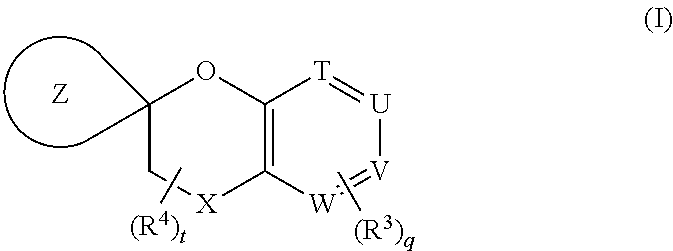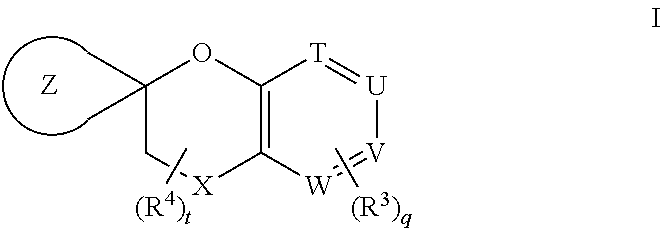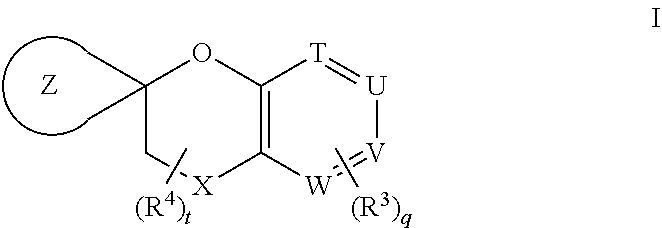Antidiabetic spirochroman compounds
a technology of spirochroman and spirochroman, which is applied in the field of antidiabetic spirochroman compounds, can solve the problems of increased and premature morbidity and mortality, induction and secretion of liver enzymes, and increased risk of macrovascular and microvascular complications in patients with type 2 diabetes mellitus
- Summary
- Abstract
- Description
- Claims
- Application Information
AI Technical Summary
Benefits of technology
Problems solved by technology
Method used
Image
Examples
example 1
Sodium (2S,3R)-3-cyclopropyl-3-(1′-(2-cyclopropyl-5-(trifluoromethyl)benzyl)spiro-[chroman-2,4′-piperidin]-7-yl)-2-methylpropanoate
[0501]
Step A: 2-Cyclopropyl-5-(trifluoromethyl)benzaldehyde
[0502]To a solution of 2-bromo-1-cyclopropyl-4-(trifluoromethyl)benzene (500 mg, 1.89 mmol) in THF (4 mL) was added butyllithium (1.13 ml, 2.83 mmol) at −78° C. The mixture was stirred at −78° C. for 30 min under nitrogen. Then DMF (0.37 ml, 4.72 mmol) was added dropwise at −78° C. The reaction mixture was stirred at −78° C. for 1 h under nitrogen. Then the reaction mixture was quenched with saturated NH4Cl (2 mL) and water (2 mL). The mixture was extracted with EtOAc (20 mL×3). The combined organic layers were washed with brine (20 ml), dried over anhydrous Na2SO4 and filtered. The filtrate were evaporated under reduced pressure to give the residue, which was purified by silica gel chromatography (SiO2, petroleum ether:ethyl acetate=20:1˜10:1, v / v) to give the title compound. MS (ESI) m / z: 215.0...
example 2
[0505]1H NMR (400 MHz, CD3OD) δ=7.43-7.36 (m, 1H), 7.35-7.26 (m, 1H), 7.14-7.04 (m, 1H), 6.78 (d, J=7.7 Hz, 1H), 6.65 (t, J=6.9 Hz, 1H), 3.94-3.85 (m, 1H), 3.00-2.90 (m, 1H), 2.83-2.72 (m, 3H), 2.57-2.42 (m, 3H), 2.26 (t, J=9.9 Hz, 1H), 1.93-1.57 (m, 6H), 1.36 (d, J=6.4 Hz, 3H), 1.12 (m, 1H), 0.88 (d, J=6.4 Hz, 3H), 0.61-0.51 (m, 1H), 0.40-0.21 (m, 2H), −0.01-−0.11 (m, 1H)
example 3
[0506]1H NMR (400 MHz, CD3OD) δ=7.41-7.34 (m, 1H), 7.34-7.27 (m, 1H), 7.14-7.05 (m, 1H), 6.79 (d, J=7.7 Hz, 1H), 6.66 (d, J=6.4 Hz, 1H), 3.65 (s, 2H), 2.83-2.73 (m, 3H), 2.72-2.64 (m, 2H), 2.63-2.54 (m, 2H), 2.26 (t, J=10.1 Hz, 1H), 1.88-1.78 (m, 4H), 1.73 (d, J=10.1 Hz, 2H), 1.17-1.05 (m, 1H), 0.88 (d, J=6.6 Hz, 3H), 0.61-0.51 (m, 1H), 0.39-0.20 (m, 2H), −0.01-−0.11 (m, 1H)
PUM
| Property | Measurement | Unit |
|---|---|---|
| enantiomeric excess | aaaaa | aaaaa |
| enantiomeric excess | aaaaa | aaaaa |
| enantiomeric excess | aaaaa | aaaaa |
Abstract
Description
Claims
Application Information
 Login to View More
Login to View More - R&D
- Intellectual Property
- Life Sciences
- Materials
- Tech Scout
- Unparalleled Data Quality
- Higher Quality Content
- 60% Fewer Hallucinations
Browse by: Latest US Patents, China's latest patents, Technical Efficacy Thesaurus, Application Domain, Technology Topic, Popular Technical Reports.
© 2025 PatSnap. All rights reserved.Legal|Privacy policy|Modern Slavery Act Transparency Statement|Sitemap|About US| Contact US: help@patsnap.com



